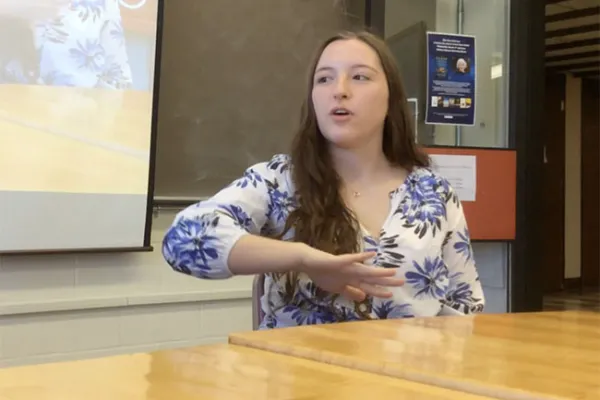No Science Jargon Spoken Here
Research & Inquiry

Published May 3, 2017
“As scientists, we are trained to speak in jargon and not to think about our audience,” says Smith astronomy professor James Lowenthal. “Bottom line: we need to become better communicators.”
During a recent media interview, Alexandria Brenon ’17 was temporarily stumped when the reporter asked her to identify reliable news sources on climate change.
After drawing a blank for a moment, she recovered and turned her answer into one about real or fake news.
“It’s important to check your sources because there are so many different things being said about climate change,” Brenon noted, as the video camera rolled. “The most important things to read are what scientists have written.”
Her answer won Brenon praise from fellow students in her Astronomy and Public Policy class, where the mock interview took place. While the videotaping was real, the interviewer was actually a staff member of Smith’s College Relations department playing the role of TV reporter.
Professor James Lowenthal designed the Astronomy and Public Policy class with funding from the National Science Foundation.
In addition to media interviews, students in the course have used theater games, practice TED Talks and group critique sessions to help improve how they communicate about science policy issues.
The learning continues this summer, when two students from the Smith class—Allison Erena ’19 and Rikki Hetland ’18—will participate in internships with the Appalachian Mountain Club, giving science talks to visitors at AMC trail lodges in New Hampshire.
An Urgent Challenge in STEM
James Lowenthal, the astronomy professor who designed the Smith course with funding from the National Science Foundation, says closing the information gap between scientists and the public is an urgent challenge in STEM.
“You can’t pick up a newspaper these days without seeing articles about policies informed by scientific research,” Lowenthal says. “But as scientists, we are trained to speak in jargon and not to think about our audience. Bottom line: we need to become better communicators.”
For his course, Lowenthal used a curriculum developed by Stonybrook University’s Alan Alda Center for Communicating Science that harnesses theater techniques to help scientists learn how to make their work more accessible to non-scientists.
Students began the Smith course without knowing that their research on one of three astronomy-related policy issues—global climate change, light pollution and contested mountaintop observatories—would also involve theater games and videotaped interviews.
They quickly rose to the challenge, says John Hellweg, Smith professor emeritus of theatre, who helped lead the class through improvisations such as playing an imaginary game of catch and competing in a storytelling relay.
“Improvisation work is vigorous and skill-building,” Hellweg says. “The students were curious and engaged and they jumped right in.”
The Power of Storytelling
Breanna Parker ’18 says encountering theater games in a science class “was a surprise—but a pleasant one!”
“It gave me a new perspective on ways to communicate and interact,” says Parker, who is majoring in environmental science and policy. “This is actually the best science class I’ve taken because of the emphasis on communication.”
Lowenthal—who participated in a two-day workshop run by the Alan Alda Center—says the program teaches the use of narrative to help bring science issues alive for the public.
Storytelling was also a focus of the practice media interviews in his class, which students did in two rounds so they could incorporate suggestions made by their classmates.
Improvements were noticeable. For example, in the second-round interview about her research on light pollution, Anjali Desai ’18 defined the problem right from the start.
“One of the main adverse effects of excess light is that it affects our circadian rhythms and causes sleep disorders,” she told the reporter. “I’ve seen that in my own baby cousins.”
“That was really a different interview,” Lowenthal said, as the camera clicked off.
Boosting Confidence
Desai’s classmates made additional suggestions, including encouraging her to use more personal experiences to get her points across.
“How long does two minutes feel when you’re doing an interview?” Lowenthal asked the group.
Not long at all, students agreed.
“When you’re watching yourself on video, though, that’s when it feels like a year!” Desai said, sparking sympathetic laughter around the room.
Brenon, an astronomy and computer science major, says the course has given her skills that will be useful as she pursues a career as a science professor or as a staff member at a science museum.
“I’ve done some theater, but I am less comfortable about public speaking—especially when it’s my own thoughts,” Brenon says. “This course has definitely made me more confident about that.”
Alyssa Cassity '20 does a mock media interview about climate change